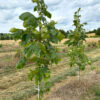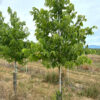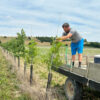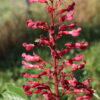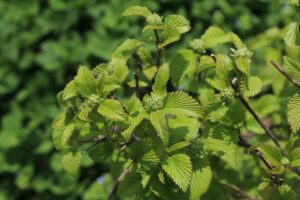
Viburnum dentatum, commonly known as arrowwood viburnum, is a large, vigorous, and highly adaptable native shrub. With a native range extending across most of southeastern North American, from southern Québec and Ontario southwest to east Texas and eastward to the Gulf and Atlantic coasts, it inhabits native environments from coastal dunes to mountain slopes. Its most favored situation is in acid-rich, moist, well-drained soils along riverbanks, but it is by far the most tolerant of viburnums in diverse conditions; tolerating both clay and sand, resisting drought when established, and hardy in cold down to at least -45 °F – USDA Zone 2. Once considered members of the honeysuckle family (Caprifoliaceæ), more recent genetic analysis has moved Viburnum to the moschatel family (Adoxaceæ) alongside the elders (Sambucus), which share a similar flower structure.
[Article continues below photos.]
In form, arrowwood viburnum is a dense, suckering shrub; typically with numerous relatively thin but strong stems. The deciduous, toothed, foliage is a glossy medium-to-dark green, ovoid, 3-4 inches in length, with numerous prominent veins radiating from the petiole, giving a passing resemblance to a hand fan. Large, cream-white corymbs of small unscented flowers appear in spring, followed by numerous small green drupes which turn bluish- to blackish-purple in autumn and are a favorite of songbirds and small animals. The autumn foliage color ranges from a dull yellow to bright orange, red, or purple.
In the landscape, Viburnum dentatum typically takes on a rounded form, usually maturing at 6 to 10 feet in height and the same in width. It is tolerant of pruning and shaping, although the timing of pruning can sacrifice flowers or fruit for a season. Besides songbirds, the plant is a host for several moth and butterfly larvae and is a favored host for both the arrowwood sallow (Metaxaglæa inulta) and the spring azure (Celastrina ladon) and is attractive to many bee species. Its preferred exposure of full sun or dappled shade and dense habit makes it a great choice in the border, especially as a backdrop to smaller shrubs or mixed perennial beds. It also has few pests and is easy to maintain once established. The specific epithet dentatum acknowledges the species’ toothed leaves, while the common name ‘arrowwood’ is a reference to usage of the thin, strong, straight stems as arrow shafts by several groups of Native Americans.
White House Natives currently has availability of Viburnum dentatum in heavy 3-4 ft and 4-5 ft sizes. This vigorous and carefree shrub deserves a place in your landscape plans.




